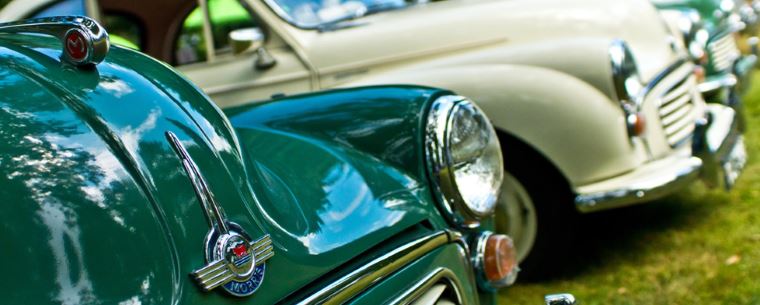Do Classic Cars Need An MOT Check? Find Out Now
Kwik Fit | Friday 22nd January 2021 9:05am

If you’re an owner of a classic car, you may be wondering what the regulations are around having it MOT tested, serviced, and taxed. The rules are not as straightforward as they are for a modern car, and there are many factors that could make your car exempt or non-exempt.
Below, we’ve identified when a classic car still requires an MOT check, as well as when this is not necessary. Read on to find out more.
When does a classic car become MOT exempt?
Previously, the Department of Transport’s regulations stated that any car that has been manufactured earlier than 1960 did not need an MOT check. In May 2018, the rules were changed and now any vehicle that is older than 40 years no longer needs to be MOT tested. This 40-year rule is a rolling date. For example, if a car was built in 1981, it will not require an MOT check from 2021 onwards. However, there are some exceptions to this rule, which we’ve listed below.
A classic car that’s older than 40 years is not MOT-exempt until you have declared it as a Vehicle of Historic Interest (VHI). This can be done at your nearest Post Office by filling out a V112 form.
Ensure that you take your vehicle’s logbook (V5C) and a valid MOT certificate from its previous test. This will also make your vehicle exempt from Vehicle Excise Duty (road tax), meaning you no longer need to pay it. However, even though no tax payment is required, the vehicle still needs to be registered for tax in order for you to drive it on public roads.
When you apply to the DVLA for your Vehicle Excise Duty, you must declare that your vehicle is MOT exempt. They may require proof that your car is a VHI.
Why are classic cars exempt from MOT testing?
The reason generally given is that owners of classic cars tend to be hobbyists, who enjoy taking care of their car mechanically. A classic car still needs to be roadworthy, so you can’t simply neglect a car and drive legally.
Driving, for example, with unsafe tyres, broken lights, or anything else that would usually fail an MOT is still illegal. The idea is that owners of classic cars will tend to be attentive to maintenance issues, without them needing to be flagged up in a formal test.
This is quite a generalisation, of course, but the purpose of the MOT test is to ensure the safety of everyone on the road – the relatively small number of classic cars on the road is therefore thought to be less likely to affect general safety.
When does a classic car need an MOT?
There are some circumstances in which your vehicle will still require an MOT check even if it’s over 40 years old. For example, if you haven’t declared it as a VHI, it will need an MOT test until it has been declared.
An MOT test is a requirement if your vehicle has been substantially altered in the last 30 years. There are some exceptions to this regulation, which we’ve explained further below. Substantial changes include chassis or sub-frame replacements and adjustments to the type or method of suspension or steering. You may be unsure whether your vehicle has had such alterations. For example, they may have been made by a previous owner. In this case, you will still need to have the vehicle MOT tested until you can prove that it hasn’t had alterations. If your vehicle doesn’t contain its original engine, then an MOT check is required.
There are, however, some non-substantial changes that are acceptable if they were completed for good reason. These changes meet this criteria if:
- They were made to preserve a vehicle and no original parts were reasonably available
- They were made when the vehicle was in production or in general use (within ten years after the vehicle was no longer produced)
- They were made to improve efficiency or safety (applies to axles and running gear only)
Buses and other forms of public service transportation will require an MOT check, even when they’re past the 40-year boundary. Commercial vehicles that have more than eight seats will also require testing. This may include classic cars that are used at weddings. Other vehicles that still require an MOT include cars with a ‘Q’ prefix in the registration number, a kit car that’s assembled from different makes and models or a reconstructed classic vehicle. However, there are still exceptions to this rule. For example, if you have a kit car that hasn’t been changed in over 30 years and has been taxed as a VHI, then it will be exempt from an MOT.
Just because your classic car is older than 40 years, this doesn’t mean that you can’t have it MOT tested. It may not be a requirement, but if you’d prefer to know that your car is working well and safe to drive, you can still take it for a test if you would like to. It’s also advised that your vehicle has a full service every year to ensure that there isn’t anything seriously wrong with it that could cause danger to you or other drivers.
Unsure about your classic car’s safety?
If you’re unsure about the condition of your classic car, or you’d simply like a professional to look it over thoroughly, put it in good hands at your local Kwik Fit centre.
Any facts, figures and prices shown in our blog articles are correct at time of publication.
Featured Articles
Is Your Car Battery Ready for Winter?
Monday 11th November 2024
Is the UK on the verge of ‘the coldest winter for 50 years?’ Even if El Niño doesn't hit the UK this winter, reduce the risk of a winter breakdown by making sure your car battery is winter-ready.
Your Ultimate Winter Driving Checklist
Monday 31st October 2022
Driving in the colder months presents many challenges. Breakdowns are far more common in winter, so make sure you’re prepared with these essentials.
How to Get Your Car Ready for Winter
Wednesday 28th September 2022
Winter can be a harsh season for your car but planning ahead by carrying out some basic maintenance and packing some essential kit should help you avoid a winter breakdown.







